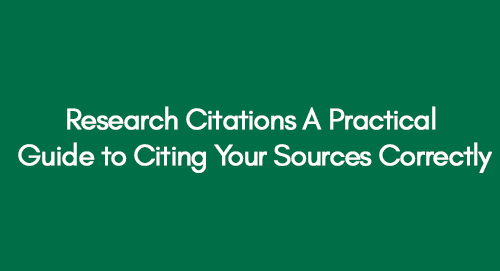
Dissertation Plan Example
May 9, 2023
15 Amazing Data Science Dissertation Topics and Ideas For Students
May 10, 2023Research citations are critical in academic writing, providing a structured way to credit and reference sources. Proper citation ensures integrity, avoiding plagiarism while allowing readers to trace and verify the information used in the research. In the expansive world of academia, where information serves as the currency of intellectual exchange, the significance of research citations cannot be overstated. These seemingly meticulous details function as the cornerstone for acknowledging the intellectual contributions of others, thereby enhancing the credibility and integrity of your scholarly work. By weaving a web of citations throughout your research, you pay homage to the ideas that have shaped your work and contributed to the broader academic conversation, creating a seamless flow of knowledge that transcends individual endeavours.
How to Write Citation? | A Practical Guide for Citation and References
Embarking on this exploration of the art and significance of research citations is akin to navigating the intricate pathways of scholarly communication. These citations not only act as signposts guiding readers through the intellectual terrain but also serve as a shield against the pitfalls of plagiarism. By embracing the responsibility to cite sources accurately and comprehensively, you actively uphold the principles of academic honesty and intellectual transparency, ensuring that your work becomes a beacon of integrity in the vast and evolving landscape of academic inquiry.
Introduction
When incorporating someone else's work or ideas into your paper, it is crucial to provide proper attribution to the source of that information. Neglecting to do so constitutes plagiarism, which can lead to severe consequences such as a failing grade for the assignment or even expulsion from school.
This guide will outline key aspects of citation writing. Acknowledging your sources is imperative to prevent plagiarism and enables your readers to locate the references you consulted if they wish to delve deeper into the subject. While numerous citation styles exist, we will concentrate on two widely used formats: MLA and APA.
What are Citations or References?
Citations serve as a means to acknowledge and give credit to the authors whose work has been incorporated into your own. They can take the form of a quote, paraphrase, or summary and play a crucial role in demonstrating that you have conducted thorough research while avoiding plagiarism.
When crafting a citation, it is imperative to include the author's last name, publication date, and page number (if applicable). For instance: (Smith, 2020, p. 3).
In the case of a direct quotation, the exact words must be included within quotation marks. For example (Smith, 2020, p. 3), "Quote goes here." Citations are integral to academic writing, emphasizing the importance of utilizing them appropriately.
Types of Citation Styles
Various citation styles are used in academic writing to format and organize references. Common types include MLA (Modern Language Association), APA (American Psychological Association), and Chicago/Turabian styles. Each style has unique guidelines for citing sources, determining formats for in-text citations, and creating bibliographies or reference lists. Choosing the appropriate citation style depends on the academic discipline and the specific assignment or publication requirements.
MLA
MLA style, prevalent in the humanities, especially in fields like English literature, languages, and folklore, relies on in-text citations and includes a Works Cited page at the document's conclusion to detail source information. Additionally, MLA is utilized in various disciplines like philosophy, history, and religious studies.
APA
APA style is commonly employed in the social sciences, including psychology, sociology, and anthropology. Utilizing in-text citations and a Reference list appended to the document's conclusion, this style offers a systematic approach to presenting source information.
Chicago/Turabian
The Chicago/Turabian style, prevalent in history and humanities disciplines, employs footnotes or endnotes and includes a bibliography at the document's conclusion to furnish details about sources.
Harvard
The Harvard style, widely adopted in the natural sciences and engineering, utilizes an in-text citation system and concludes with a reference list at the end of the document to convey information about sources.
Vancouver
Vancouver style is employed in medicine and the sciences, featuring a numbered citation system within the text and a corresponding reference list at the document's conclusion to offer comprehensive information about sources. Disciplines such as nursing and dentistry rely on the Vancouver style for citing their sources.
IEEE
IEEE style is commonly applied in engineering, computer science, and electronics, employing a numbered citation system in the text and featuring a reference list at the document's conclusion to furnish comprehensive information about sources. This style is also widely utilized in diverse disciplines, including mathematics and physics.
How to Cite Sources in IEEE Format?
Elements to Include
Writing a citation follows different norms for different publications. How to write a citation for a journal will be different from books and websites.
For Journals:
- Authors
- Year of publication (enclosed in round brackets)
- Article title (enclosed in single quotation marks)
- Journal title (in italics, with the first letter of each word capitalized, except for linking words)
- Volume number
- Issue number (if applicable, enclosed in round brackets)
- Page numbers or article reference numbers (provide the full page range for the entire article and the specific pages cited)
- For online-only articles, include a DOI or website URL.
For Books:
- Authors or Editors
- Year of publication (enclosed in round brackets)
- Title (in italics)
- Edition (if applicable)
- Place of publication
- Publisher
- Series and volume number (if applicable)
Websites:
- Author (individual or company responsible for the webpage)
- Year of publication or most recent update (enclosed in round brackets); if no date is available, write (no date)
- Page Title (in italics)
- Accessible at: URL (Accessed: date)
Organization's Databases:
- Publishing organization
- Year of publication/last updated (enclosed in round brackets)
- Title of the report (in italics)
- Available at: URL or DOI (Accessed: date)
Newspapers:
- Author(s) surname and initials
- Year of publication (enclosed in round brackets)
- Title of the article (in single quotation marks)
- Title of the newspaper (in italics, with the first letter of each major word capitalized, except for linking words)
- Edition (if applicable, enclosed in round brackets)
- Day and month
- Section and page reference (if available)
Difference Between MLA and APA Formats
The major differences between MLA and APA formats are as follows:
MLA Formatting
MLA (Modern Language Association) is commonly applied in humanities papers, such as English or History. The citation method involves parenthetical citations within the main body of the paper. For each source, include the author's last name and the page number where the information is found. For instance:
Smith (42) states, "MLA formatting is not as difficult as it seems."
In this example, "Smith" is the author's last name, and "42" is the page number. Additionally, a Works Cited page is included at the end of the paper, listing all sources used. The format for each entry varies by source type, but every listing should include at least the author's last name and the working title.
Example of an MLA Works Cited page:
Works Cited "Article Title." Website Title. Date Published. URL. Accessed Date Accessed. "Another Article Title." Another Website Title. Date Published. URL. Accessed Date Accessed. Smith, John. Book Title. City Published: Publisher, Date Published. Print.
APA Formatting
APA (American Psychological Association) is commonly employed for papers in the social sciences, such as Psychology or Sociology, utilizing parenthetical citations within the paper's body. Unlike MLA, APA includes the author's last name, publication date, and page number (for direct quotes) in the parenthetical citation, as illustrated below:
Smith (2020) states, "APA formatting is not as difficult as it seems."
Crafting APA Dissertation Format | A Step-by-Step Guide
This distinctive inclusion of the author's last name and publication date sets APA apart from MLA formatting. Like MLA, every source used in an APA paper should be documented on a reference page titled "References" at the end of the document. The entries on this page will vary based on the source type, but each listing should include at least the author's last name and year of publication:
References Smith, J. (2020). The article title goes here [Type of Medium]. Retrieved from http://www......com/article-title-goes-here/
Conclusion
Mastering the art of citation and acknowledging sources might appear overwhelming initially. Still, as you become accustomed to either MLA or APA formatting, it will become a routine skill! Remember that failing to credit someone else's words or ideas amounts to plagiarism. Therefore, consistently adhere to proper citation practices to prevent any complications with your educators.
Get 3+ Free Dissertation Topics within 24 hours?



























